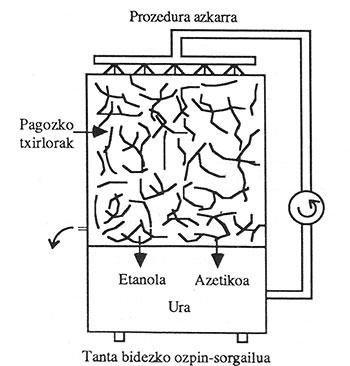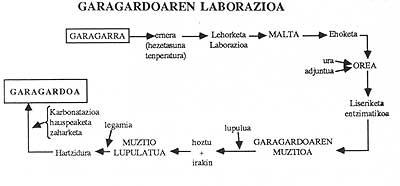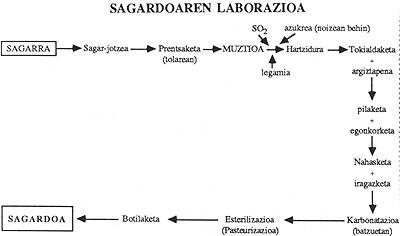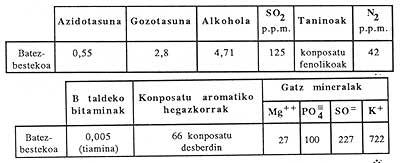Microbiological production of beverages
Beer Beer Beer
Drink A. There is a written footprint of the manufacture of Mesopotamia and Egypton around 6000. Beer is malt drink (alcoholic fermentation with hop from the aqueous extract of malted barley) and may contain other carbohydrates (sugars), called adjunctions. To obtain this precious liquid, the following process is performed:
The barley used can be of two types: Hordeum disticarto or Hordeum hexasticum.
The first one provides a sweet beer that is easily wasted. The beer obtained from the second is more sustainable.
We have two yeasts of beer: S. cerevisiae: (for "ale" beer), S. uvarum: (in the case of beer "lager").
Fermentation begins when we inoculate the must 7.106 cells/ml of yeast must. The carbon and energy necessary for the growth of the yeast are obtained from the sugars of the must.
The hop, a type of plant, gives flavor and casing to the beer.
Fermentation begins in aerobic conditions, but then there is anaerobiosis; fermentation runs through the metabolic pathway Embden-Meyerhoff-Parnas (called glycolysis by biochemicals):

Wine Wine Wine
It is a drink obtained by the alcoholic fermentation of the ripe and dry grape wicker.

Champagne is a type of wine and the water of Bilbao is a carbonated wine.
The yeasts used in the case of wine are: Saccharomyces cerevisiae and Saccharomyces aviformis.
The fermentation runs along the path of the E.M.P. and the reaction is:
G. G. GLUCOSE 2 ETHANOL + 2 CO 2 + by-products in small quantities.
Stoichiometric 51.1% ethanol and 48.9% CO 2.
Main by-products: glycerol, lactic acid, acetaldehyde, 2,3-butanodiol, succinic acid, acetic acid and major alcohols.
Three types of wine analysis are performed:
- Sensitive analysis: appearance, aroma, bouquet, flavor. Microbiological analysis: microscopic study and platelet for the observation of yeasts and bacteria.
- Physico-chemical analysis: acidity, alcohols, carbamyl compounds and phenolics, compound nitrogen and color delimitation.
In Europe, and also in Euskal Herria, the consumption of wine is decreasing for the benefit of beer. The most windy areas of Euskal Herria, Navarre and especially the Rioja alavesa. In the latter, the wine represents 80% of the Gross Added Value of the primary sector. In 1985 the harvest was huge (10,000 kg grapes/Ha). Compare these data with those of the table and with the means of La Rioja, that is, seeing 5900 kg/Ha, the data of our Rioja are very remarkable.
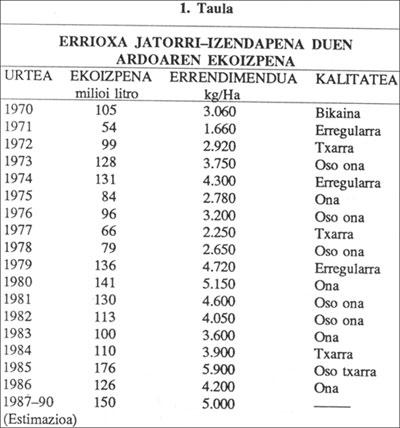
Cider cider Cider

Apple juice is fermentation. The fruit belongs to the species Malus pumida.
With the name of Britaina Haundian cider is known the result of an alcoholic fermentation without an apple wicker boil.
In the US, on the other hand, it is known as hard cider the result of the alcoholic fermentation of the apple and of the apples and pears, mixed or not with water, always taking into account that the amount of pear should be less than 25%.
The elaboration of the cider is done through the processes exposed in the previous scheme.
As a result of the study of 15 ciders, the following data were collected:
In Hego Euskal Herria there are almost five million liters of cider (especially in Gipuzkoa) and we have sixty-five cider. They have a great future, since the market is gradually expanding, but with firmness.
Whisk and whisk
This drink is called in Scotch with the word uisge beatha (ie, water of life). It is a consumable spirit, obtained from the distillation of the malted barley and the fermented extract of other crops. The yeast used is Saccharomyces cerevisiae. The relationship between beer and whisky is great and therefore we can give a second definition of whisky. Specifically:: Distillate of beer without lupular.
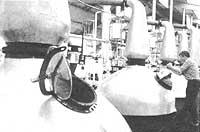
To obtain the Scottish whisky we leave the malted barley, ground and kneaded, to later perform the enzymatic transformation of the starch; later the must cools and the mixture is carried to the cuba with yeasts. The fermentation is carried out by Saccharomyces cerevisiae and the specific weight of the must is maintained up to the value 1. At that time it is taken to distillation still, called Wash alanbike. Here is done the first distillation, which passes to low wines still. In it the second distillate is obtained. The following is done:
- The first and last fraction return to distillate.
- The central fraction passes to the stacking basins; to the burnt oak basins. Then go to the bottles.
For the manufacture of Scotch whisky, the two barley species mentioned above in the case of beer are used.
Whiskys are in most cases blended, that is, mixed, and belongs to the youngest whisky that participates in the age mix. Scottish drinks are classified into two groups: Highlands and Lowlands, according to their geographical origin.
Alcoholic distillates
In general, distillate cultivation consists of four steps. Specifically::
- Grinding + kneading Sacarification Fermentation
- Distillation of distillation
Below are some alcoholic distillates:
- VODKA: Distilled aromatized and not aged. It can be obtained from corn, millet and rye. GENEVA: Juniper berries are used to aromatize. The gin is distilled aromatized. Native Dutch; XVIII. from the beginning of the century. Contains 2% sugar. RUMA: Distillate of fermented products of cane sugar. It does not suffer aromatization. BRANDY (or cognac): It begins with the fermentation of the grape of Saint Emilion. The fermented must is distilled twice and the first complete distillate is taken together with the central fraction of the second distillate. This distillate is preserved for years (up to forty years) in oak vats. The oak wood gives organoleptic characteristics to the brandy. TEQUILA: It has its origin in Jalisko (Mexico). It is produced from the extracts of the hooks Agabe or Pita. The tequila is not aromatized.
Vinagre vinegar
One of the drinks of microbiological origin is vinegar. Perhaps the word drink is quite inadequate. And it is that although it is quite used in our salads, we do not drink, except in the case of certain pickled wines.
To obtain vinegar, the wine was wasted. Therefore, it was an acid wine. Then some advances were known, including the Orleans process, the face and the slow process. All of them are not currently used. In fact, XIX. Since the twentieth century a new method has been used: it is a rapid process and a process of cultivation submerged since 1949. In the fast process a generator of vinegar of drops is used. See figure 4.
In the immersed cultivation process, the Acetator generator is used, the most advanced and profitable. It can be seen in figure 5.
Fermentation: Ethanol is transformed into acetaldehyde and water, then acetaldehyde is hydrated in O 2 and appears acetic and water.
The stoichiometry of this exothermic reaction is:

What microorganisms intervene in this process? These are:
Gluconobacter (before Acetobacter): Gluconobacter oxidans Gluconobacter suboxidans
Acetobacter genus: Acetobacter xilinum
